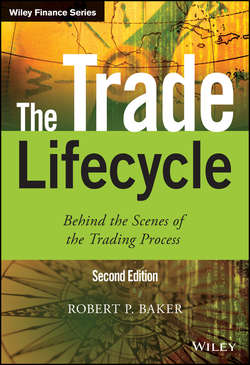Читать книгу The Trade Lifecycle - Baker Robert P. - Страница 27
На сайте Литреса книга снята с продажи.
Part One
Products and the Background to Trading
Chapter 3
Understanding Traded Products – Follow the Money
3.5 Swap
ОглавлениеThe term swap is very general, giving rise to many meanings (e.g. commodity swap, FX swap, credit default swap etc). However, when otherwise unqualified, it is taken as being an interest rate (IR) swap.
The simplest form of interest rate swap is a trade with several pre-defined settlement dates and a nominal notional amount of money that is never exchanged. One side (by convention the buyer) pays a fixed amount on each settlement and the other side pays a floating amount determined by some reference index (such as LIBOR). This is known as a fixed for floating swap (see Figure 3.7). The size and direction of each settlement is unknown at time of transaction. Shortly before each settlement date, the two sides determine the amount to be paid or received by looking at the reference index (a process known as fixing; the date is known as the fixing date).
Figure 3.7 Cashflows on swap trade
For example, the IR swap is defined by:
■ Notional USD 1m.
■ We pay fixed rate of 3 %.
■ We receive float of LIBOR USD 6m rate.
■ Settlement every six months for 2.5 years.
Suppose that just before the first settlement, after the trade has been running six months, a fixing of the reference index (LIBOR USD 6m) is taken and found to be 2.5 %.
So we pay 3 % of 1 million and receive 2.5 % of 1 million. This results in us making a net payment of USD 5000.
Now, at the second settlement after 12 months, suppose the reference index is 3.2 %. Therefore we pay 3 % of 1 million and receive 3.2 % of 1 million. So we receive net USD 2000.
This process continues for each settlement period of the swap.
Common variations are floating-floating and currency swaps. A floating-floating swap is where both sides have a floating amount determined by two different reference indexes. For example, we pay LIBOR USD 3m and received LIBOR USD 6m (the 3m being a different index to the 6m).
A currency swap (not to be confused with an FX or foreign exchange swap) is where the two sides are in different currencies. For example, we pay fixed 3 % of a dollar notional and receive a floating rate in euros based on LIBOR EUR, which is then converted to dollars at the prevailing foreign exchange rate on fixing day to determine the direction and size of settlement.
Although there is always a notional amount in any interest rate swap, this is never actually exchanged. It is only used for determination of amount to be paid or received.
